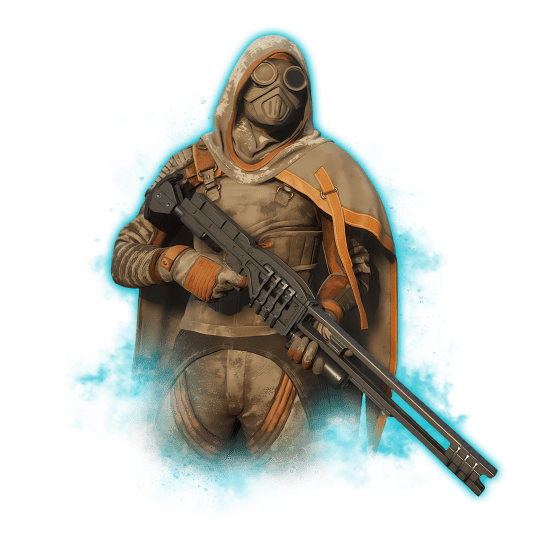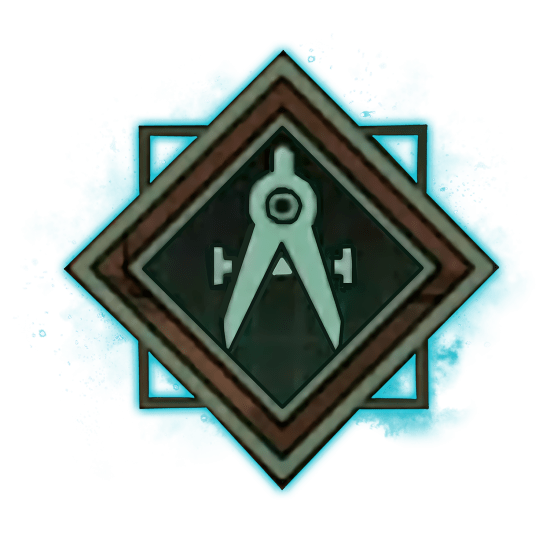Welcome to the Dune Awakening beginner’s guide, agents of Bene Gesserit! This is the second game in the last five years set in the amazing universe created by Frank Herbert. The game takes place in an alternative timeline and answers the question, “What if Paul Atreides was never born?”, which gives a whole new spin on the familiar events and characters. You play as a prisoner sent to Arrakis as a Bene Gesserit agent, tasked with finding remaining Fremen who have been allegedly exterminated by Emperor Shaddam IV’s elite forces Sardaukar.
This is an online survival game that plays a lot like Conan Exiles, made by the same developer, Funcom. Whether or not you played that game, this guide will cover how to play Dune Awakening and all of the things you need to know about it - from mechanics that are unique to this game to the things that are common between many games in this genre.
Craving endgame action without the slow climb? Grab your Dune Awakening Powerleveling boost at Skycoach and hit max level in record time. Speedy service, unbeatable rates, and absolutely no stress.
Note: At SkyCoach, you can Buy Dune Awakening Boost at the best prices with fast delivery. Use our special PROMO CODE (in green) hidden in this article for a 20% DISCOUNT.
Character Creation and Classes
This game places an unusually deep emphasis on character expression and identity. And so, for this Dune Awakening starter guide, I decided to touch on the character creation a little bit.
Character creation is more than skin-deep. Your choices during this stage shape your dialogue options, starting abilities, faction reputation, and survival strategies across Arrakis. These choices are permanent, though the game later allows skill cross-training and flexible class progression.
Character Appearance

Before selecting your background and class, you’ll first customize your character’s physical appearance. This includes:
- Body type and build
- Facial structure and age
- Hair styles and color
- Tattoos, scars, and makeup
These elements are purely cosmetic, offering no gameplay advantage, but they allow players to ground themselves in Dune's aesthetic and lore.
Homeworld: Where You’re From
Your character’s Homeworld influences how NPCs react to you, unlocks a unique emote, and grants a passive bonus. These traits subtly shape your early interactions and quest opportunities.
| Planet | Dialogue Trait | Unique Emote | Gameplay Bonus |
| Caladan | Honorable | Atreides Salute | +15% water efficiency |
| Giedi Prime | Ruthless | Harkonnen Gesture | +20% crafting speed |
| Chusuk | Artistic | Musical Flourish | +10% social influence |
| Kaitain | Aristocratic | Imperial Bow | +25% reputation gains |
| Ix | Analytical | Technical Gesture | +15% tech research speed |
Here’s one of the Dune Awakening tips: the best pick for beginners is Caladan – the water efficiency bonus has a direct survival impact, especially early on.
Caste: Your Social Standing
Caste determines your starting social class in the Imperium, affecting your dialogue, reputation, and starting gear. It reflects how noble, skilled, or expendable you are in the eyes of others on Arrakis.
| Icon | Caste | Trait | Interaction Bonus | Starting Gear |
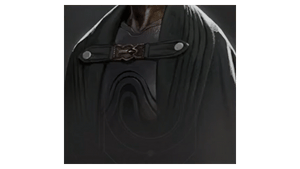 |
Bondsman | Resourceful | +20% with working class | Work tools |
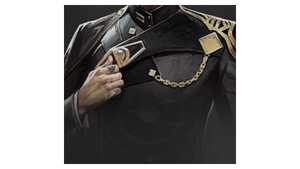 |
Na-Familia | Commanding | +15% with noble NPCs | Quality clothing |
 |
Pyon | Practical | +10% with merchants | Specialist equipment |
Best pick for versatility: Bondsman – it balances NPC influence and survival benefits without locking you into a specific political identity. BLOG20
Mentor: Your Starting Class
Your Mentor defines your starting skill tree and combat style. This choice determines your first ability, your early strengths, and how you'll survive your first encounters on Arrakis. While you can eventually learn from all archetypes by training with different NPCs, your initial mentor strongly shapes your early gameplay experience.
| Class | Focus | Starting Ability | Skill Bonus | Ideal For | Difficulty |
| Swordmaster | Melee combat, burst damage | Deflection – Enter a stance to block incoming attacks | +15% melee damage | Solo PvP, aggressive duels | ★☆☆ (Easy) |
| Mentat | Recon, traps, precision shooting | The Sentinel – Deploy a motion-triggered turret | +20% scanning range | Tactical players, ambush builds | ★★★ (Challenging) |
| Bene Gesserit | Mind control, influence, CC | Voice: Compel – Force an enemy to move toward you | +10% influence range | Support roles, manipulation builds | ★★★★ (Hard) |
| Trooper | Mid-range combat, demolition | Shigawire Cable – Grapple to terrain or enemies | +15% damage resistance | Balanced gameplay, easy PvE entry | ★★ (Beginner) |
Each class comes with sub-paths—called sub-classes—that allow for deeper specialization over time. These sub-paths, like The Weirding Way for Bene Gesserit or Tactical Tech for Troopers, give players the ability to further tailor their role in both PvP and PvE encounters.
While your mentor choice is permanent, the game’s open skill system ensures that you're never boxed into a single playstyle. For example, a Trooper can later learn scouting tools from the Mentat tree, or a Swordmaster can augment their aggression with stealth or sabotage abilities. What your mentor really gives you is a head start—not a restriction.
Planetologist: Unlockable Exploration Class

Unlike the other four archetypes, the Planetologist is not available during character creation. Instead, it must be unlocked later in the game by discovering a specific NPC in the world and completing a task-based questline. This quest begins at Griffin’s Reach Tradepost, located in the southern region of Hagga Basin.
Once unlocked, the Planetologist opens up a new skill tree focused on exploration, resource gathering, and environmental adaptability. It’s a class tailored for players who want to specialize in survival, navigation, and supporting resource operations across the harsh deserts of Arrakis. While it lacks combat abilities, it plays a critical role in PvE progression and long-term economic strength.
Character Progression - Leveling & Quests
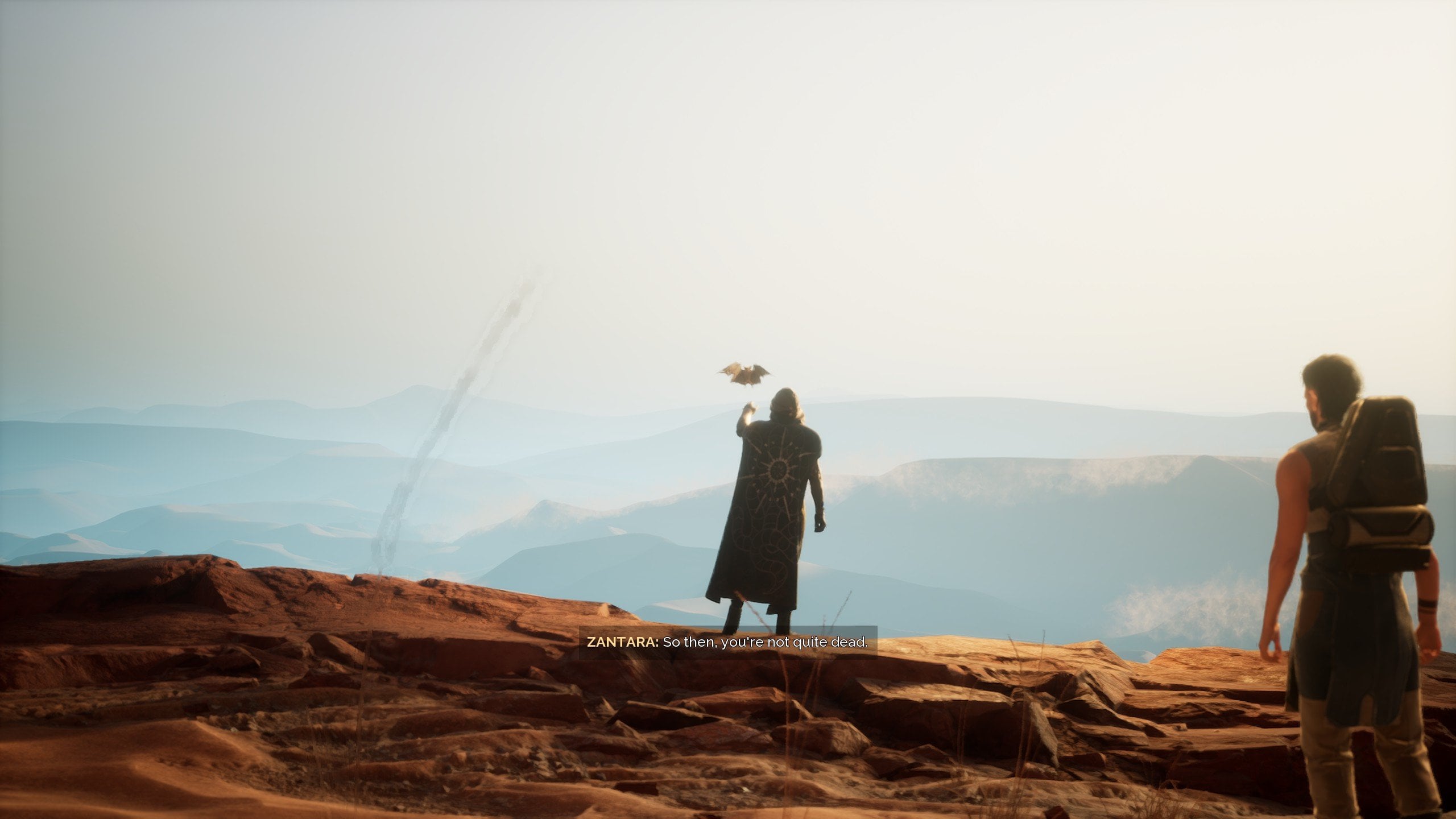
This section of the Dune Awakening new player guide focuses on character progression. Now, the progression system is both expansive and flexible, rewarding players not just with raw stats or gear, but with new abilities, crafting potential, and access to deeper class systems. Whether you're focused on combat, survival, exploration, or politics, leveling your character opens up tools to specialize or diversify as you see fit.
Leveling Rewards: Skill Points & Intel Points
Each time your character levels up, you gain two key currencies:
- Skill Points – Used to unlock abilities, passive traits, and techniques within a skill tree.
- Intel Points – Spent on crafting technologies and blueprints through the Research Menu.
By the time you reach Level 200, you’ll have accumulated:
- 199 Skill Points – allowing for deep investment in one archetype or hybrid builds across multiple classes.
- 2,779 Intel Points (ending at Level 125) – used to unlock gear schematics, tech upgrades, and specialized equipment.
Higher levels don’t just increase your power—they expand your options. You’re not limited to your starting class; you can unlock new skill trees by training with NPC mentors found throughout Arrakis.
Abilities, Passives, and Techniques
The Skill Tree system is built around three core elements:
- Abilities – Active powers (you can slot up to three) that define your combat or utility loadout.
- Passives – Always-active bonuses that boost everything from stamina efficiency to weapon effectiveness.
- Techniques – Optional modifiers that fine-tune how an ability behaves in specific situations.
This modular approach encourages customization. For example, a Mentat might learn stealth techniques from the Bene Gesserit tree, or a Trooper could add mobility perks from the Swordmaster path. The deeper you level, the more hybrid your build can become.
Research & Crafting Progression
Your Intel Points feed directly into crafting progression. Using the Research Tab, you can unlock:
- Equipment schematics (weapons, armor, survival gear)
- Tech upgrades for vehicles, base components, and tools
- Utility enhancements that adapt your loadout to different environments
Crafting is central to surviving on Arrakis—and mastering it is a long-term reward for players who invest heavily in Intel-based progression.
Questing and Storyline Progression
Questing ties directly into your progression, offering not just XP but access to new skill trainers, faction storylines, and unlockable features. The main storyline is shaped by your background (Homeworld, Caste, Mentor) and faction alignment, with unique paths available for those who side with:
- House Atreides
- House Harkonnen
- The Bene Gesserit
- The Fremen
Your choices affect dialogue outcomes, mission types, and access to reputation-based content.
Major quests can also gate new systems—like unlocking the Planetologist skill tree or gaining access to Deep Desert expeditions.
Dune Awakening Water Management and Survival
You can’t call this a Dune Awakening complete guide without covering some of the unique survival mechanics.
So, this game introduces a layered and immersive survival system centered around water, temperature, and environmental hazards. Players must constantly balance hydration, shelter, and mobility to stay alive in a world that punishes recklessness. All of that comes on top of the usual survival game hazards - hostile players and base raiding.
Hydration: The Core Survival Resource
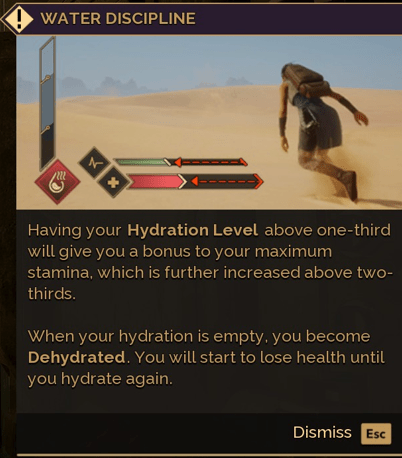 Water is life on Arrakis, and your character’s Hydration Level is as important as health or stamina. Maintaining hydration is essential for staying mobile and effective in combat or exploration.
Water is life on Arrakis, and your character’s Hydration Level is as important as health or stamina. Maintaining hydration is essential for staying mobile and effective in combat or exploration.
Hydration Benefits and Risks:
- Staying above one-third hydration increases your maximum stamina.
- Above two-thirds, you gain even greater stamina regeneration.
- Let it drop to zero and you'll become Dehydrated, causing health loss until rehydrated.
Early on, you’ll rely on Dew Flowers to stave off dehydration. These wild plants provide limited moisture, but can only fill up to one-third of your bar. Overconsumption causes nausea, forcing you to seek better solutions.
Advanced Hydration Sources Include:
- Stillsuits – Recycle your body’s moisture and create a backup water reserve.
- Windtraps and Dew Fields – Base structures that passively generate water.
- Blood Harvesting – Extract blood from enemies, purify it at base, and convert it to drinkable water.
- Dew Reapers – Plants or tools that passively extract moisture from the air.
These systems not only keep you alive—they’re tied to crafting, faction politics, and late-game content.
Sunstroke and Heat Exposure
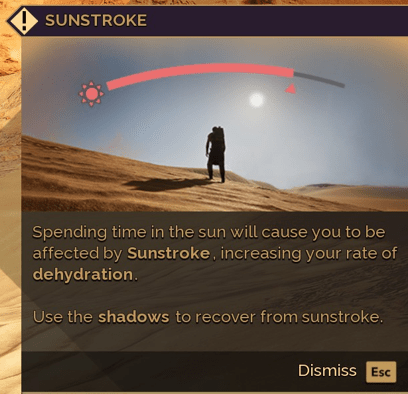 During the day, extreme heat accelerates hydration loss and can cause Sunstroke. When this debuff sets in:
During the day, extreme heat accelerates hydration loss and can cause Sunstroke. When this debuff sets in:
- Your hydration drains faster.
- Movement and stamina recovery suffer.
- You must find shade or shelter to recover.
Spending time in caves, under cliffs, or wearing heat-resistant gear helps mitigate the effect. A very obvious trick is to wait until nightfall. During the night, you’re not risking to get a sunstroke, so you can do whatever you need to do without worrying about the sun.
Sandworms and Vibration
Arrakis' most iconic threat is the Sandworm—a massive predator drawn to rhythmic movement on open sand. A vibration meter tracks your impact on the terrain:
When it turns red, a worm is closing in.
You must stop moving, use rock surfaces, or escape to safe zones.
Heavy gear, thumpers, vehicle engines, and even shields can increase your vibration profile.
Environmental Threats & Systemic Hazards
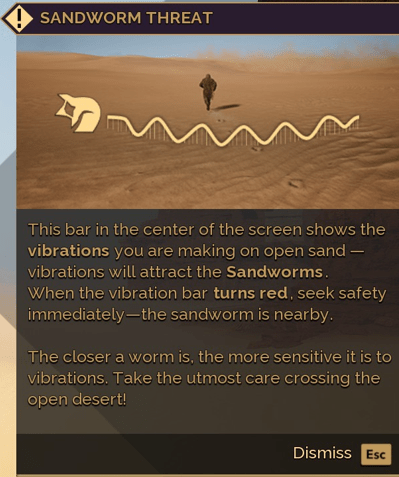
Arrakis is alive, and the environment itself can kill. Key threats include:
- Coriolis Storms – Massive storms that sweep the Deep Desert weekly, destroying unshielded structures and wiping temporary bases.
- Drumsand / Quicksand – Terrain traps that can immobilize players or vehicles, usually found near ruins or cliffs.
- Sardaukar Night Raids – Elite NPC strikes triggered by player notoriety. Fast-moving pods deploy squads that flank and overwhelm unprepared players.
- Sandstorm Damage – Bases not fully enclosed (four walls + ceiling) will take damage during sandstorms unless shielded.
While most of these aren’t present in the starting location where you can more or less safely explore and build your first home, the Sandstorms do deal a lot of damage when they come around. You will get about a 2-minute warning about an upcoming Sandstorm, and you better hide behind some rock, inside any structure, whether it’s your base or a tradepost. Because if you get caught by the Sandstorm out in the open, your health will deplete so quickly that you won’t survive more than a minute! Plus if you have a bike that’s not been safely stored, it will get damaged too, and you’re risking losing it!
Base Building Explained
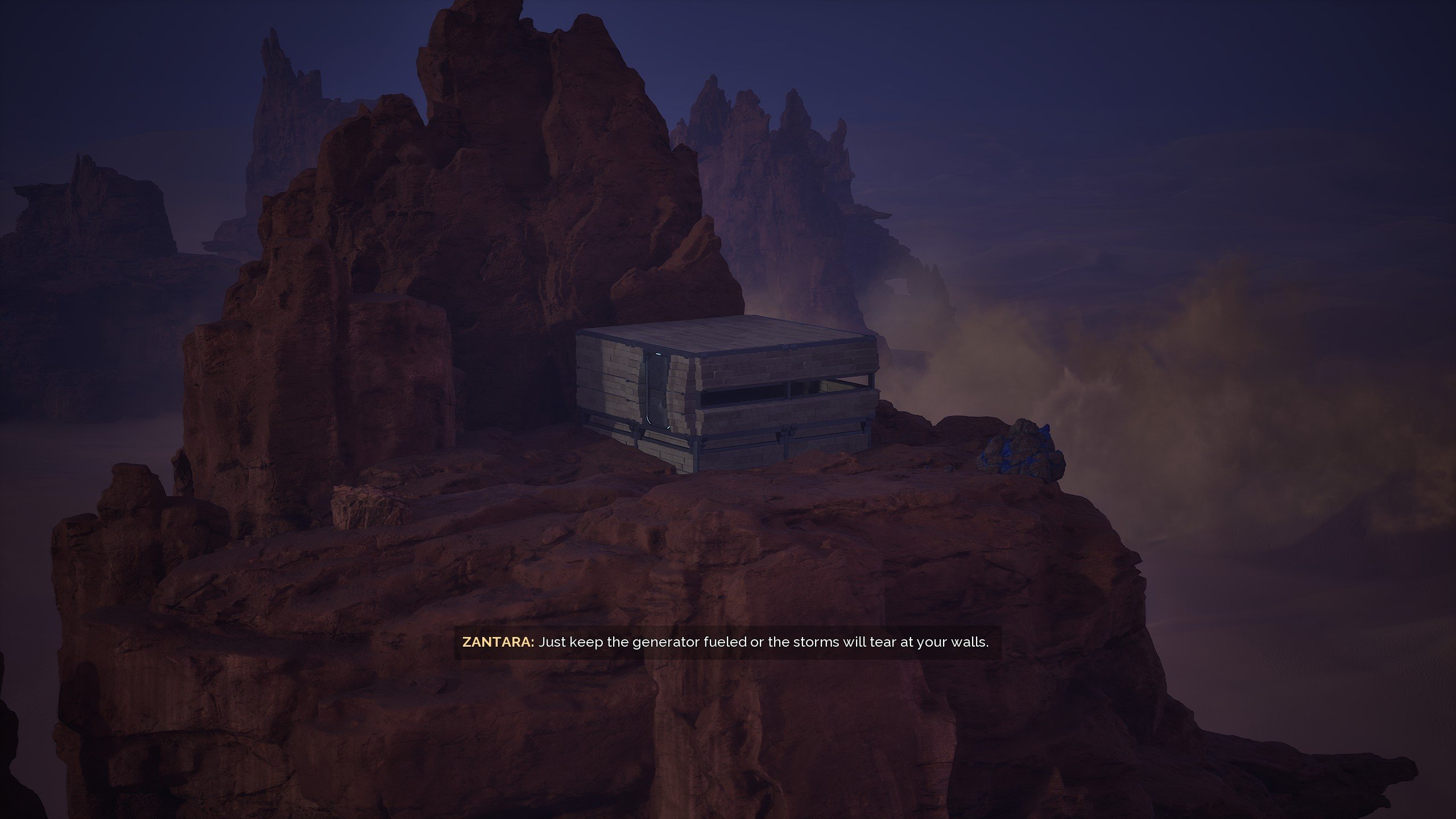
Base building in this game begins early in the main story, but it quickly becomes central to survival, crafting, and progression. If you’ve played survival games like Rust, Conan Exiles, or SCUM, the process will feel familiar—but with its own Arrakis-specific twists. And if you want to know how to start playing Dune Awakening as a beginner, you need to know what goes into base building.
How to Get Started
During the Dune Awakening tutorial, you’re prompted to build your first structure and learn the fundamentals. To claim land and begin construction, you need two things:
- Solido Construction Projector – a tool used to build and place structures.
- Sub-Fief Console – the central control unit of your base.
Once you place the Sub-Fief Console, you’ll see the boundaries of your claim. This device handles land control, access permissions, and power routing. You can rotate and elevate it as needed to fit your chosen terrain.
Land Claim & Permissions
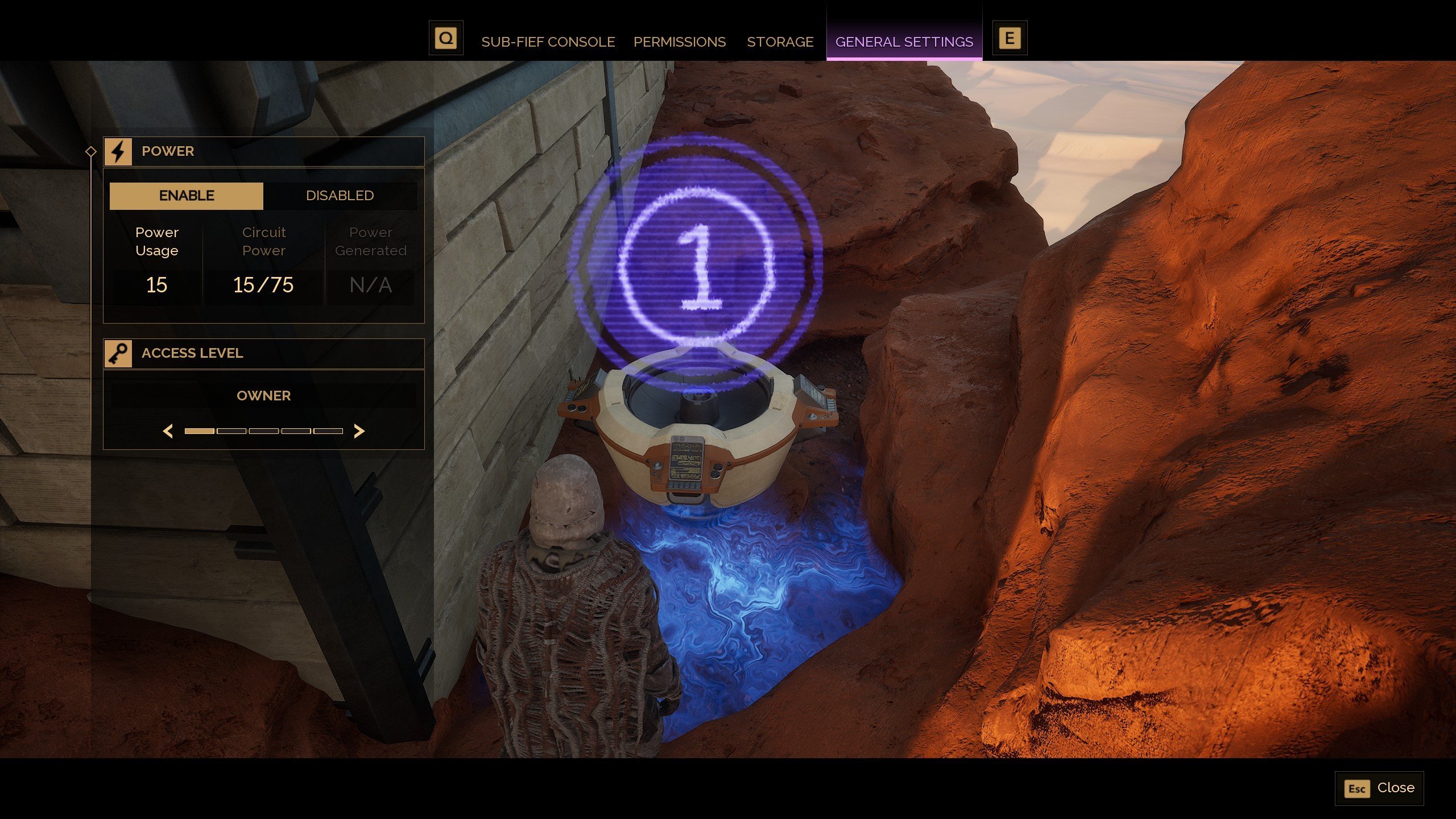
After placing your Sub-Fief Console, your buildable area becomes clearly visible. Within that zone, you’re free to place foundations, walls, and machines. You can also assign access levels to your base, ranging from private to public:
- Only you
- You and friends
- Default (you and your current party)
- Clan/guild members
- Public
This system lets you control who can enter or interact with specific items like doors, fabricators, and storage crates.
Building Your First Shelter
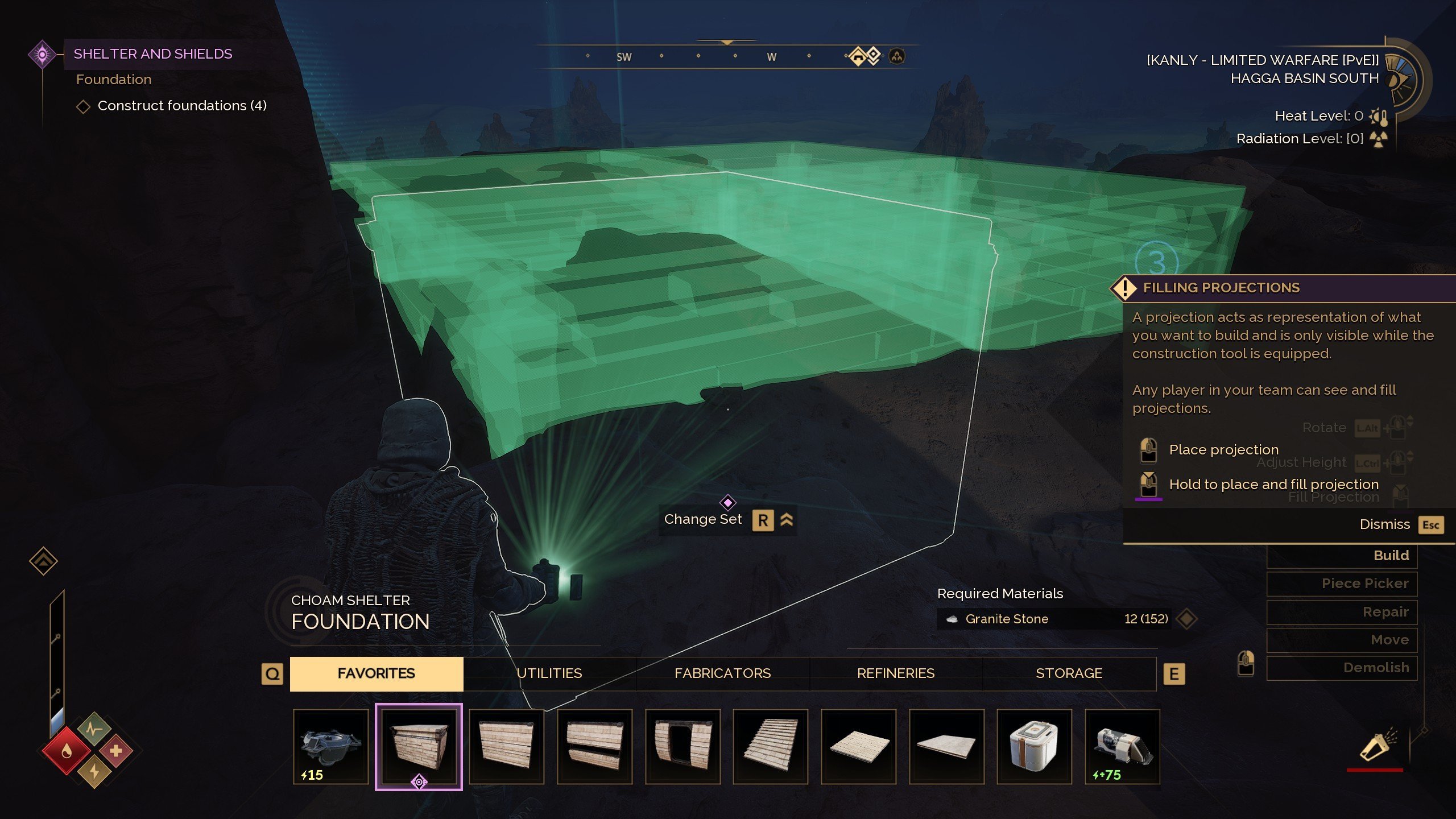
The tutorial requires you to build a basic shelter using:
- 4 Foundation tiles
- Walls (windowed or solid)
- A door
- A roof
This process uses a projection system: you first place holographic blueprints, then finalize them by holding to build with the required materials (like granite stone). The interface includes five tabs:
- Favorites – quick-access to selected pieces
- Utilities – includes the Sub-Fief Console and Generator (for base upkeep)
- Fabricators – core crafting benches like the Fabricator
- Refineries – for processing resources, such as the Copper Refinery
- Storage – small crates for storing excess items
Early base contents typically include the Generator, a storage crate, a Copper Refinery, a Fabricator, and one essential machine: the Blood Purifier.
Power & Upkeep
Bases require upkeep, and it’s managed by your Generator. You’ll need to insert fuel periodically to prevent your walls from decaying—especially during sandstorms. A small UI near the generator shows how much power is being used versus how much is available.
Keep an eye on this, or you may find yourself without shelter after a storm rolls through.
“Just keep the generator fueled or the storms will tear at your walls.” – Zantara (NPC)
Additionally, your base has a decay timer. The more upkeep resources you add, the longer it will remain stable. This is visible in the Sub-Fief Console.
Crafting Stations and Progression
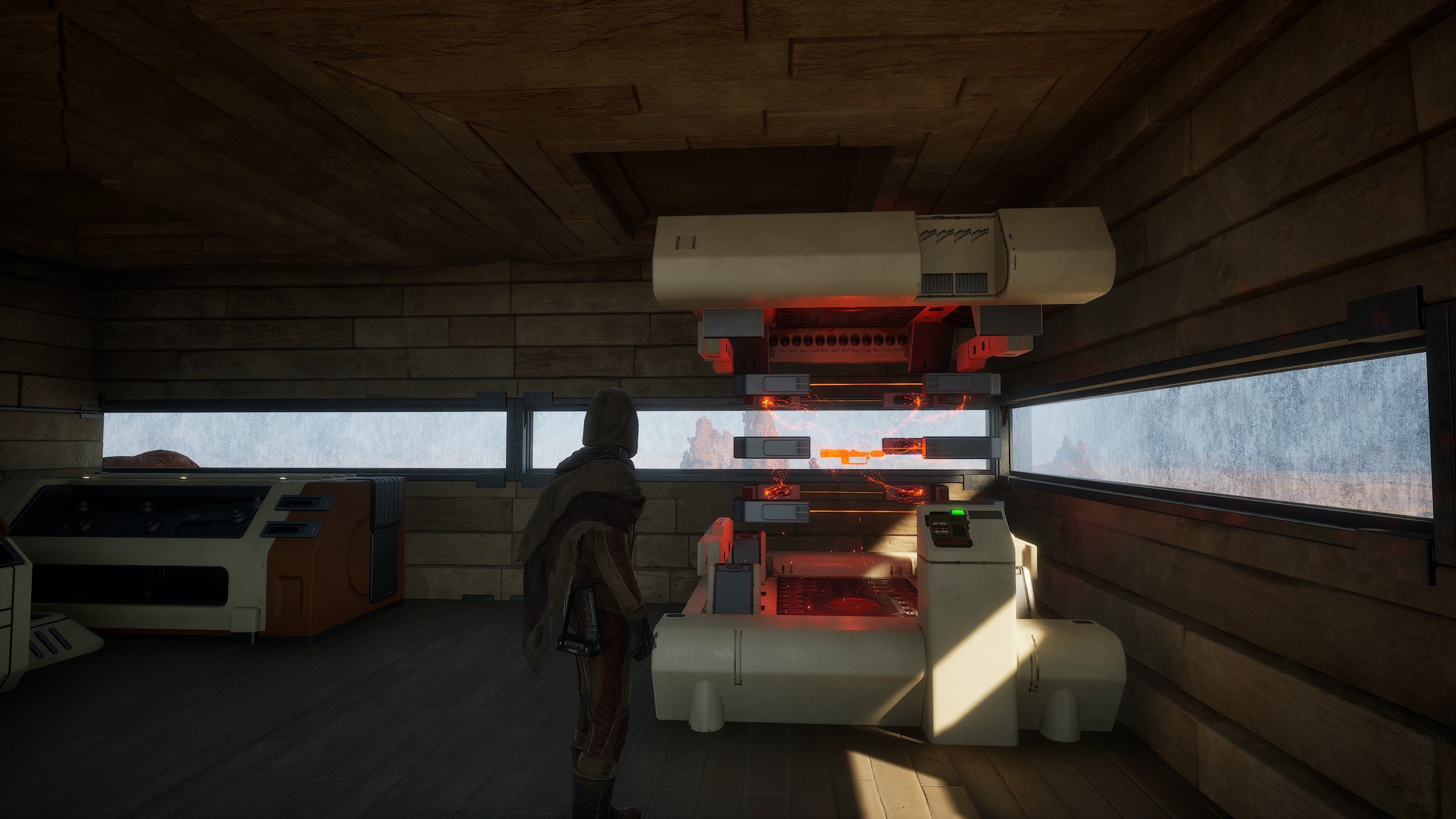
If you want to know how to start Dune Awakening with a good base, there are some essential things that you need to install. These include:
- Fabricator – This is your main crafting bench, where you’ll make stillsuits, tools, and vehicle parts. It includes built-in storage for completed items.
- Refineries – Machines like the Copper Refinery convert raw resources into usable materials for crafting.
- Blood Purifier – Tied to the survival loop, this station processes blood harvested from defeated enemies into drinkable water.
The Blood Purifier is introduced through the story and becomes your most reliable long-term hydration source. You collect blood with a Blood Extractor and Blood Sack, then purify it back at base.
Storage & Expansion
Initially, you’ll only have access to a small crate, but it’s essential. As your inventory fills during early quests, you’ll need this space for materials, fuel, and spare gear.
Fabricators, refineries, and even storage items follow the same access level system—so you can control who has permission to use each.
Portability & Relocation
Later in the game, you’ll unlock a tool that lets you copy your base layout and move it elsewhere. You can abandon your current base through the map menu, then use that tool to rebuild the entire structure (including contents) at a new location. This adds flexibility without losing your progress.
Crafting and Resource Gathering
Crafting is central to survival, progression, and self-sufficiency. From your first stillsuit to the construction of weapons, tools, and base components, everything depends on your ability to gather the right materials, refine them properly, and assemble them at the correct workstations. It’s a multi-stage process, and every step matters.
The Crafting Loop: From Resource to Product
Crafting begins with gathering raw materials from the world around you. These are then processed at specialized workstations into usable components, which are finally assembled into equipment, consumables, or construction pieces.
The basic crafting loop looks like this:
- Gather materials (stone, scrap, biomass, etc.)
- Refine them at appropriate stations (e.g., copper ore → copper ingots)
- Craft gear or structures using recipes unlocked via research or progression
Basic crafting can be done from the inventory, but soon enough you’re going to need to build your first crafting bench called “Fabricator” in your base.
Gathering Basics
Early resource gathering is mostly done by hand or with basic tools like the Cutter Ray, which lets you mine stone or extract biomass. Key raw materials include:
- Scrap Metal – found near wrecks and ruins, used in tools and weapons
- Granite Stone / Sandrock – used for building foundations and walls
- Organic Biomass – collected from plants or enemies; used in fuel and medicine
- Spice Residue – a byproduct of spice harvesting, used in tech crafting
These materials are mostly found in your starting zone and don’t require advanced tools—though harvesting speed improves with upgrades.
Gathering Mechanics: Cutteray and Resource Nodes
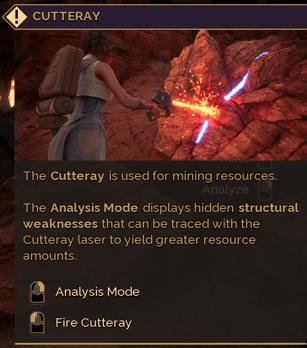 Unlike most survival games where you simply swing an axe at a node, Dune: Awakening uses a more interactive gathering system. The primary tool is the Cutteray, and using it involves a simple but immersive two-step mini-game:
Unlike most survival games where you simply swing an axe at a node, Dune: Awakening uses a more interactive gathering system. The primary tool is the Cutteray, and using it involves a simple but immersive two-step mini-game:
- Scan the node using Analysis Mode – this reveals a highlighted trace line that marks the resource’s weak point.
- Switch to Fire Mode – carefully cut along the revealed trace to break the node and extract materials.
This system applies to everything from basic stone and biomass nodes to sealed containers and wreckage. Some objects—like crashed ornithopters—require multiple scan-and-cut cycles and reward significantly more valuable scrap metal. You’ll also loot tools like the Cutteray from enemy corpses early on, which becomes essential for further progress.
Refinement: Turning Raw Into Useful
After gathering, you'll need to refine many materials at specific stations before you can use them. For example:
- Copper Refinery – processes ore into copper
- Blood Purifier – refines blood (from enemies) into clean water
- Fabricator – handles the final step for many items: stillsuits, knives, components
Each station requires power, which is managed by your base’s Generator. Some stations have their own internal storage and access settings.
Crafting from Inventory
It might not be evident at first, but one of the Dune Awakening tips for beginners is that the starting equipment can be crafted from the inventory. This includes:
- Basic clothing
- Healing bandages
- Knives and other starting gear
This is useful to know because you don’t have to rush back to your base when you’re out of healing bandages or weapon darts. Once your Fabricator is built, you’ll gain access to deeper recipes and unlock the ability to craft more specialized items using refined materials.
Materials: Types & Tiers
You’ll encounter several categories of materials in the world:
- Raw Materials – e.g., Scrap Metal, Biomass, Stone
- Refined Materials – e.g., Alloys, Polymers, Circuitry
- Fluid Resources – e.g., Water, Fuel Cells
- Rare Materials – appear later, often tied to environmental events or hostile zones
Each material has its own purpose and rarity. Efficient storage, transport, and use of materials becomes increasingly important as your base grows.
Research and Recipes
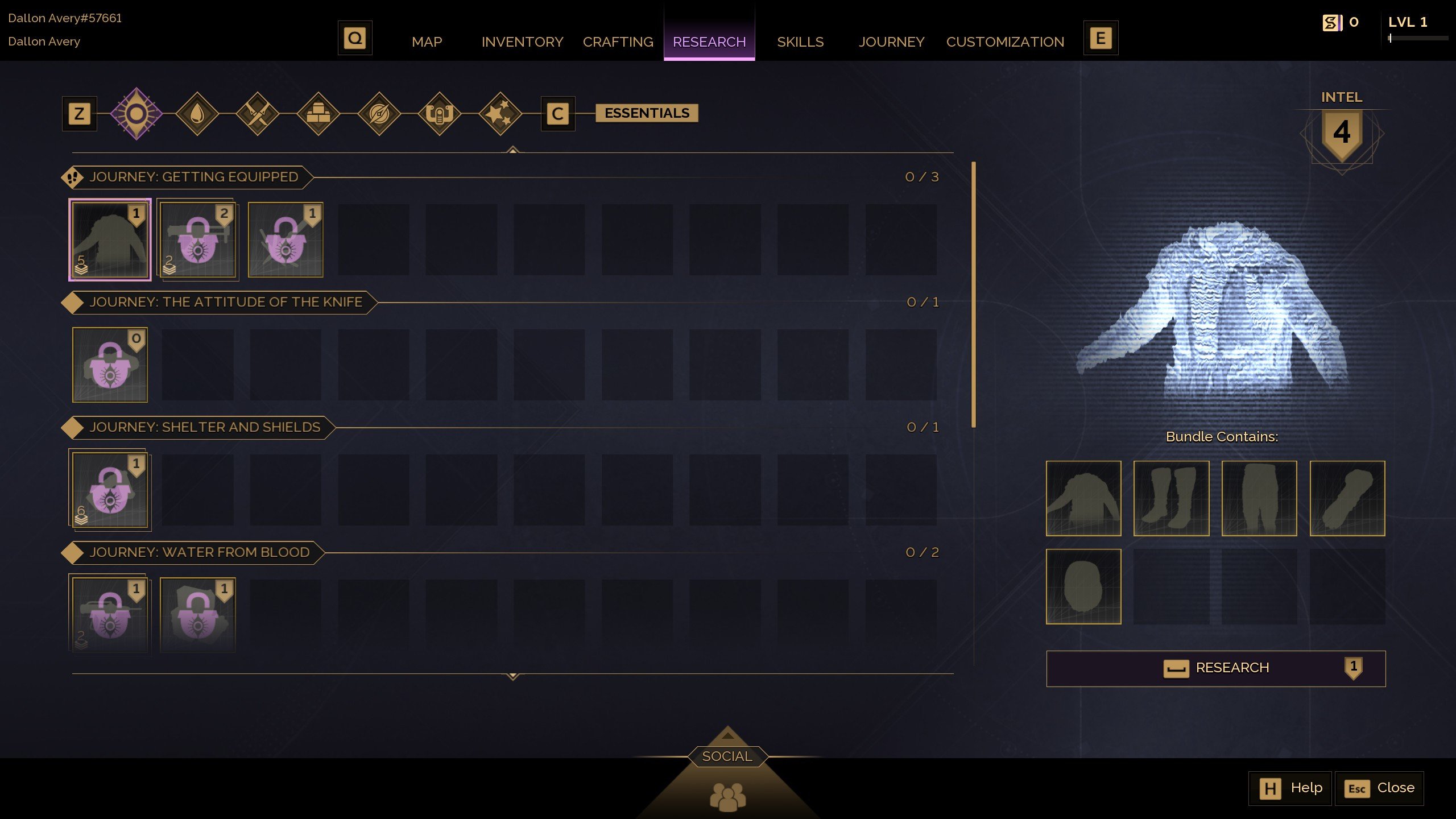
Researching or unlocking recipes is a core part of character progression outside of combat. It allows players to unlock crafting blueprints for tools, armor, base structures, survival equipment, and more. Whether you're focused on survival, exploration, PvP, or economy, the Research menu provides the gateway to specialization and self-sufficiency.
What Is Research?
Research is how you unlock schematics—crafting blueprints for essential equipment and upgrades. While some recipes are earned through quests, most must be unlocked manually using a resource called Intel Points. These are spent within the Research interface to grant access to crafting new items at your fabricators and workstations.
Every player benefits from research. Regardless of your class or chosen School of the Imperium, the research system lets you tailor your crafting to suit your playstyle—whether that’s desert survival, stealth-based combat, or economic dominance.
Intel Points: Your Research Currency
Intel Points are used to unlock schematics within the Research menu. You’ll earn Intel Points through:
- Leveling up
- Exploring new zones and scanning POIs
- Clearing enemy camps
- Activating scanning nodes in the environment
These points accumulate fairly quickly early on, but many recipes require more than one, making it important to choose your unlocks strategically.
Dune Awakening tips for new players: During the tutorial, you’ll likely earn more Intel Points than you can spend. Early research is mostly linear—many schematics are locked behind completing specific tutorial quests and marked with a purple lock icon.
How the Research Menu Works
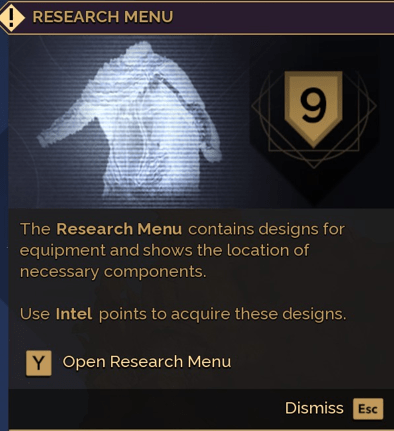 The Research screen is organized into categories (or "disciplines"), each representing a different aspect of gameplay. You’ll navigate tabs based on your focus—Combat, Water, Exploration, etc.—and choose which blueprints to unlock as you progress.
The Research screen is organized into categories (or "disciplines"), each representing a different aspect of gameplay. You’ll navigate tabs based on your focus—Combat, Water, Exploration, etc.—and choose which blueprints to unlock as you progress.
Each unlock shows:
- Intel cost
- Schematic description
- Required components
- Which workstation is used for crafting
- Unlock status or prerequisites
This abundance of information helps you to make a sometimes difficult decision of where to invest the Intel, even if you don’t have that long-term plan. BLOG20
Early Research Structure: “Essentials” Tab
At the beginning of the game, your Research window includes an Essentials tab, tied directly to tutorial milestones. Blueprints here include:
- Basic armor set (shirt, pants, boots)
- Starting gear recipes
- Tools like the Blood Extractor
- Shelter components
These recipes unlock automatically once you complete their associated quests—so even if you have Intel Points, you may not be able to access them until you progress the storyline.
Schematics: One-Time Crafting Unlocks
In addition to permanent research unlocks, you’ll also find schematics throughout the game world. These are special, single-use blueprints that grant a one-time crafting charge for unique or rare items.
You can find schematics through:
- Exploration – caches, caves, ruins, and intel points
- Factions – by gaining favor with Houses or groups
- Trading – bought from merchants or other players
- Mission Rewards – often granted from major quests
To use a schematic:
- Take it to a research station (in a hub or your own base)
- Research it to gain a one-time crafting charge
- Use a fabricator to craft the item
Once the item is lost or destroyed, you must reacquire the schematic to make another
This system adds strategic weight to item use and incentivizes exploration and faction alignment.
Research Categories

As you expand your base and access new areas, you’ll gain access to more specialized research trees, including:
- Water Discipline – hydration gear, dew collectors, moisture tools
- Combat – weapons, armor upgrades, gadgets
- Construction – storage, structural upgrades, utilities
- Exploration – traversal gear, scanning tools
- Vehicles – (not covered here; separate section)
- Uniques – rare recipes found in the wild or through trade
Each category caters to a specific gameplay style, making research a vital tool for shaping your path through Arrakis.
Dune Awakening Combat System
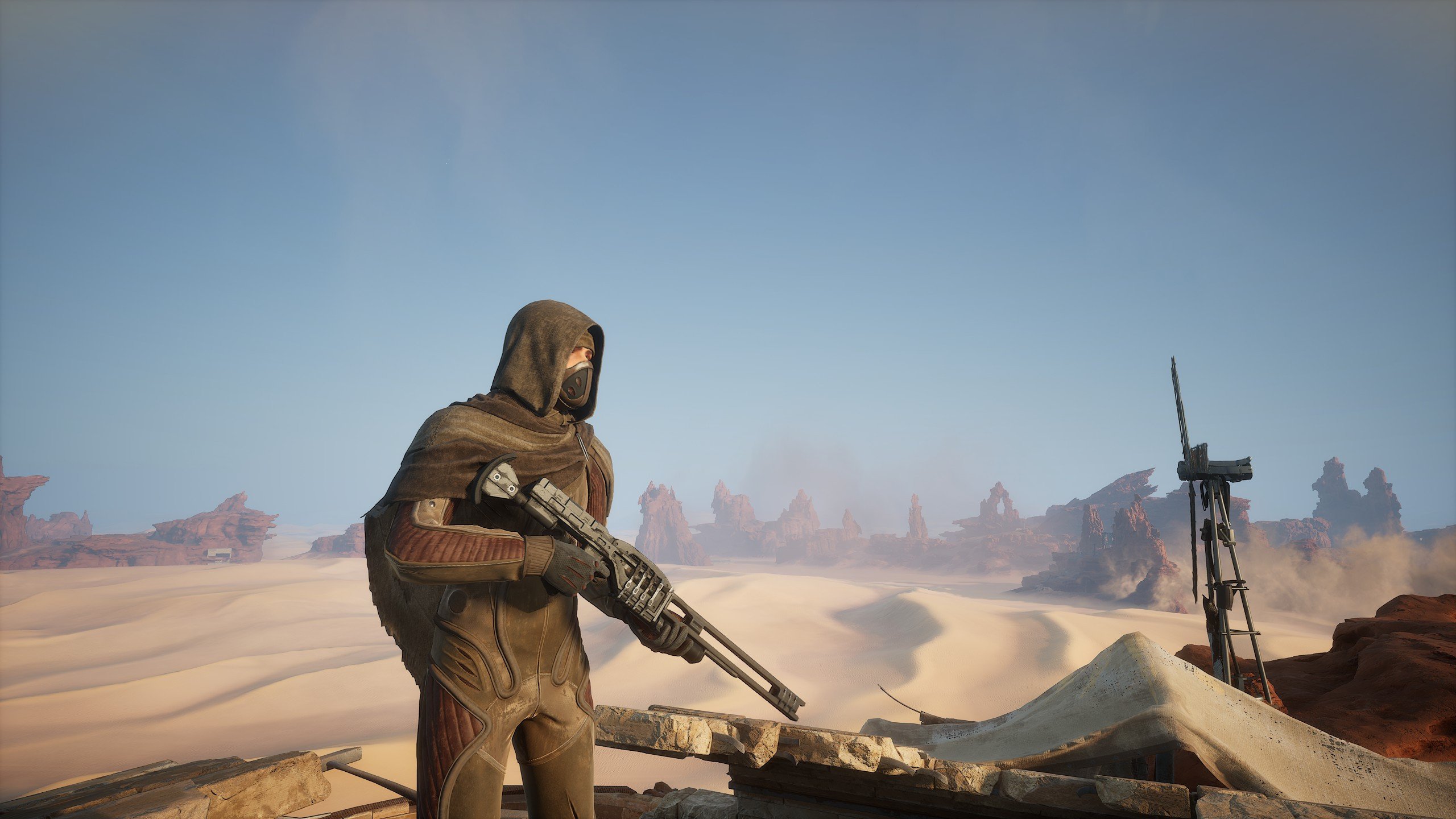
Combat in this game is real-time, tactical, and highly situational. It combines MMO-scale battles with survival-style stamina and resource management, emphasizing both strategic class ability use and fast reflexes. Whether you’re using a stealth approach, going in guns blazing, or switching to a blade mid-fight, combat is a core pillar of the gameplay loop—and understanding its flow is essential.
Core Combat Mechanics
At a glance, combat revolves around:
- Stamina – needed for attacks, dodging, and sprinting. Hydration boosts stamina, regen and capacity.
- Health – depletes quickly in the early game without solid armor.
- Hydration – indirectly supports your combat ability by boosting stamina and regeneration.
- Shields – protect you from damage, but open tactical weaknesses.
Melee and Ranged Combat Basics
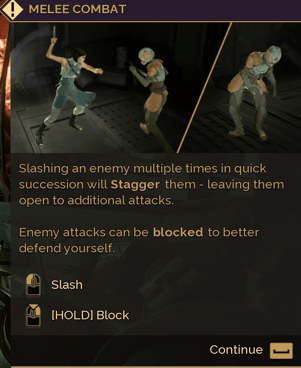 You’ll start your journey crafting a Scrap Metal Knife, a short blade made from salvaged metal. It’s not just your first weapon—it’s also used to cut through environmental obstacles like biological membranes.
You’ll start your journey crafting a Scrap Metal Knife, a short blade made from salvaged metal. It’s not just your first weapon—it’s also used to cut through environmental obstacles like biological membranes.
Despite your class or combat preference, you’ll use both melee and ranged weapons in early combat.
Melee Combat
Melee attacks help stagger enemies, creating openings for combos or special finishers. You can also:
- Block incoming melee attacks
- Parry by timing your block just before an enemy hits—this stuns them
- Slow Blade Attack (hold button) to pierce through shields
This is especially important when facing shielded enemies, who are resistant or outright immune to ranged weapons. The only way to reliably defeat them early on is to stagger them, then perform a Slow Blade attack.
Ranged Combat
At the start of the game, ranged combat revolves around dart-based weapons like the:
- Maula Pistol – first sidearm you can craft
- Karpov 38 Rifle – your second weapon, decent range, and RoF
Ammo is crafted in packs of 30 and is relatively cheap using scrap metal. However, early-game darts deal almost no damage to shielded enemies, making them useful primarily for unshielded targets. Later on, you’ll be able to craft heavier weapons that deal more damage and use other ammo types.
Shields and Tactical Counters
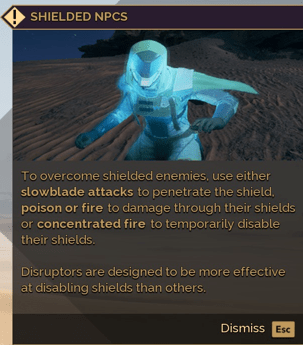 Many enemies use Holtzman shields. These block most ranged damage and force you into close quarters unless you have specialized weapon types or use Slow Blade techniques.
Many enemies use Holtzman shields. These block most ranged damage and force you into close quarters unless you have specialized weapon types or use Slow Blade techniques.
To counter shields:
- Use melee Slow Blade attacks
- Apply fire or poison effects (via later tech)
- Use disruptor-type weapons (faster shield breakers, not early-game gear)
Shields also play a role in PvP and late-game PvE—but in the Deep Desert, activating shields can attract sandworms due to the vibrations they emit. This introduces a layer of risk even in defense.
Weapon Switching & Combat Flow
You can swap between melee and ranged weapons on the fly, and you’ll need to. Shielded enemies often appear alongside regular ones in larger camps. Expect to:
- Shoot one enemy at range
- Dash into melee to parry another
- Quickly switch back to finish off a target
Early combat especially rewards fast swaps and awareness of enemy types.
Combat Abilities & Classes
Each archetype offers unique abilities that change how you fight. While this section of the Dune Awakening guide doesn’t dive into specific skills, know that:
- Abilities define your combat identity
- You can mix skills from different schools as you level up
- Spice enhances combat temporarily through Prescience boosts
Examples include:
- Compel – forces enemies to move or freeze
- Knee Charge – closes distance
- Gravity Grenade – staggers enemies in an area
- Invisibility – used by stealth classes for repositioning
These abilities have cooldowns and often tie into your stamina or class resources. You’ll unlock more as you explore the Skills tab and progress.
How to Make Vehicles in Dune: Awakening
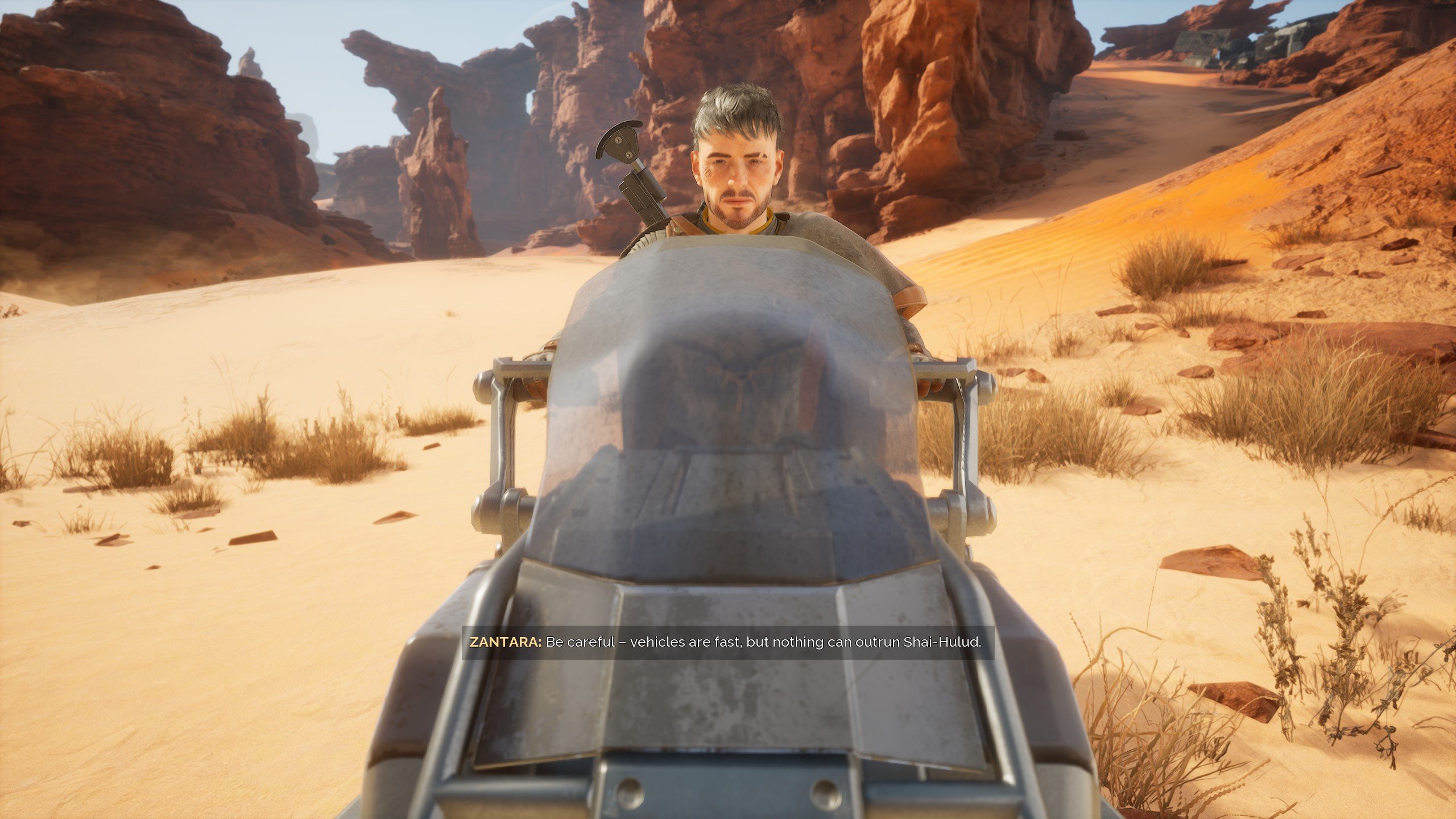
Vehicles are critical to survival, exploration, and crafting logistics on Arrakis. With the vastness of the desert and the constant threat of storms or sandworms, you're going to need a ride sooner than later. Arrakis is mostly a desert. While the game map has lots of points of interest, they’re still pretty far away from each other, and you’re going to realize the importance of having something to drive after the first 30 minutes of running around.
There are three drivable vehicles currently in the game:
- Sandbike – Lightweight solo transport, the first vehicle you build
- Buggy (Quad Ground Car) – Mid-game group vehicle with modular attachments
- Scout Ornithopter – Agile aerial unit for scouting and fast traversal
Your first vehicle that you'll make will be the Sandbike.
Building the Sandbike: Your First Vehicle
The Sandbike is introduced during the main story/tutorial progression and acts as your entry point into the modular vehicle system. It’s a fast, solo vehicle that you assemble entirely from scratch using the Fabricator in your base.
Required Core Components
To craft a working Sandbike, you need five essential parts:
- Sandbike Chassis Mk1 – The base frame
- Sandbike Engine Mk1 – Controls speed and acceleration
- Sandbike Hull Mk1 – Driver seat and structure
- Sandbike PSU Mk1 – Handles power efficiency and heat dissipation
- Sandbike Treads Mk1 (x3) – Three separate tracks for movement and grip
All five components are individually crafted at your Fabricator once you unlock the blueprints and gather the required materials.
Unlocking Vehicle Blueprints
Vehicle crafting begins after you unlock the Sandbike blueprints via the Research menu, using Intel Points gained from exploration and missions. Some modules may require completing tutorial milestones to become available.
Where to Find Vehicle Components
 Vehicle-related parts—especially rare materials like Advanced Servoks and Particle Capacitors—are found in Eco Labs. These are special instanced POIs (points of interest) marked on the map.
Vehicle-related parts—especially rare materials like Advanced Servoks and Particle Capacitors—are found in Eco Labs. These are special instanced POIs (points of interest) marked on the map.
- Eco Labs typically contain puzzles, ID-locked doors, and modular crafting components
- These labs usually loop back to the entrance, so you won’t get stuck
Completing them is often required to progress vehicle assembly. One of these Eco Labs is the Imperial Testing Station No. 2 located in the center of the Hagga Basin.
Assembling the Sandbike
Once all parts are crafted and stored in your inventory:
- Equip your Vehicle Construction Tool
- Place the Sandbike Chassis
- Use the same tool to attach each module: engine, hull, PSU, and treads
- Finalize assembly and mount your new Sandbike
You’ll later be tasked with crafting and installing additional modules like an Inventory Pod. This expands your bike’s storage capacity—essential for long-distance gathering or hauling.
Vehicle Tools: Construction, Repair, Storage
Vehicle interaction in Dune uses three key tools:
- Vehicle Construction Tool – For assembling and adding modules
- Repair Tool – For fixing damaged vehicles
- Vehicle Backup Tool – Lets you store your vehicle and redeploy it later
The last one is super cool, as it practically lets you keep your vehicles in your pockets without needing to store them in a base’s garage or anywhere else. The tool has its own capacity, but it’s still a great thing to have if you plan on making a vehicle.
Upgrades and Customization
Your Sandbike isn’t stuck in its starter form. You can enhance its performance with optional modules:
- Inventory Modules – Add extra storage slots
- Boosters – Short bursts of acceleration, useful for dodging sandworms or escaping PvP ambushes
- Scanner Mk II – Lets you scan for resources without dismounting
Each module must be welded onto available utility slots using a Welding Torch, and all components must match the tier of the chassis.
Trading and Endgame PvP in Dune Awakening
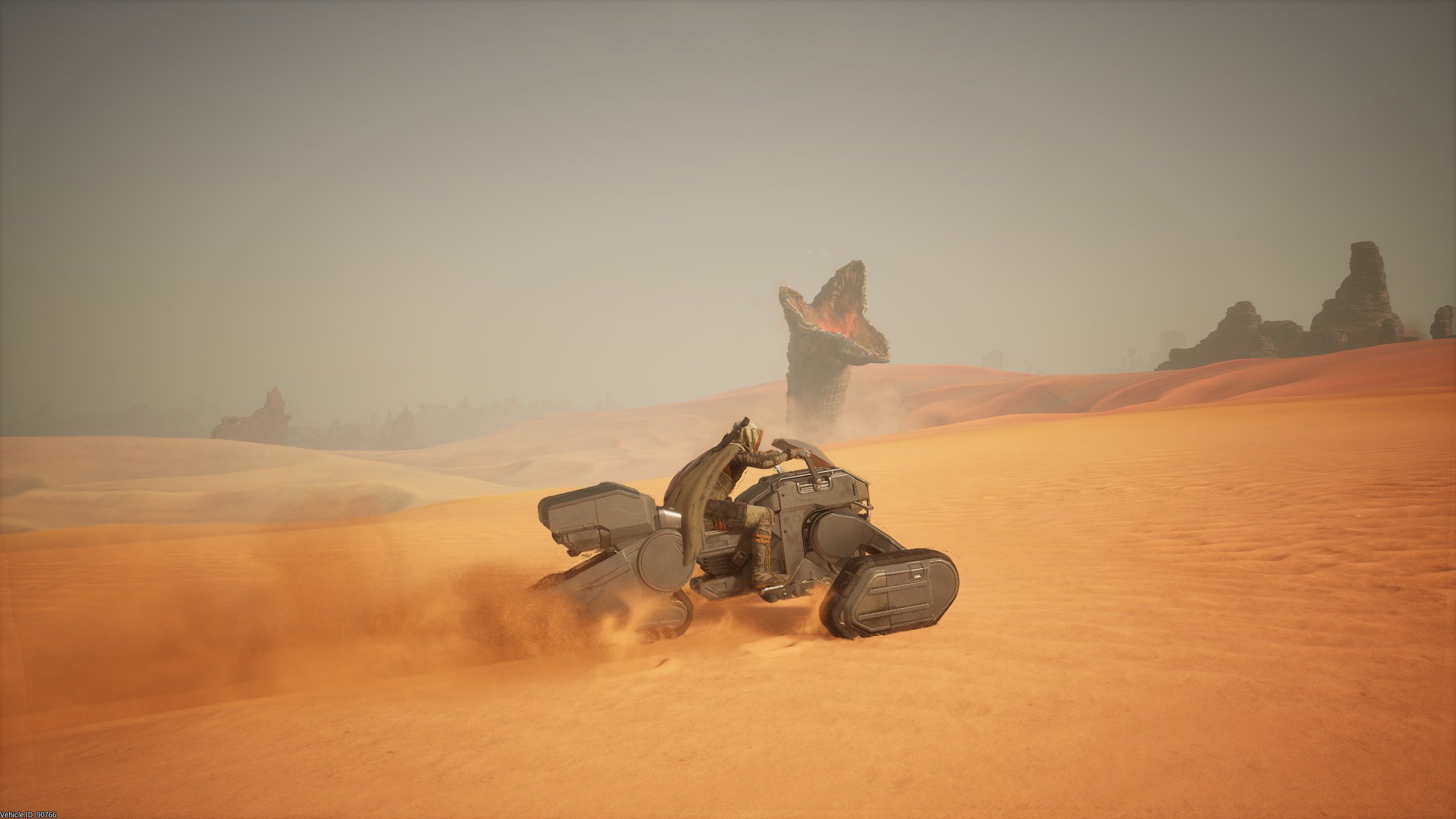
The economy, politics, and endgame conflict on Arrakis are all tightly interconnected. From faction alignment to the deep desert’s high-stakes PvP zones, everything you do feeds into a larger world system governed by player influence, reputation, and cooperation—or competition.
Whether you’re a trader, explorer, PvE crafter, or hardcore PvP raider, these systems create meaningful opportunities and rewards across the game’s social and competitive spectrum.
The Exchange: Global Trade in a Player-Driven Economy
The Exchange is this game’s auction house—accessible only in major social hubs like Harko Village or Arrakeen. It's a world-linked marketplace where players from different servers (within a shared “world”) can buy and sell items, gear, blueprints, and even player-designed buildings.
Here’s what makes the Exchange so unique:
Architectural Blueprints: Players can upload and sell custom base layouts using the Replicator system
- Sync Charts: Created via surveying and cartography in the Deep Desert—map data that reveals hidden resources and points of interest
- Unique Schematics: Found through exploration or deep PvE, then sold directly or used to craft rare gear to sell
- Faction-Aligned Vendors: Some of the best gear and tools in the game are locked behind decree-based vendors—only accessible when your faction wins the political endgame
You’ll earn Solari from sales and also spend it on high-end gear, maps, and services. Stock rotates, so checking back regularly is essential.
Going Solo vs. Aligning with a Great House
Players can choose to remain Freelance, operating outside the faction system—or align themselves with one of the Great Houses, such as House Atreides or House Harkonnen.
Factions matter because:
- They grant access to unique quests, gear, and decree-based buffs BLOG20
- Your performance directly feeds into the Landsraad political meta, which reshapes the rules of the entire world
- Only aligned players in guilds can participate in the Landsraad endgame, competing for global control
Remaining Freelance may offer flexibility and freedom from faction-wide taxes and obligations—but it cuts you off from world-shaping rewards and endgame influence.
The Landsraad: Political PvP for Power
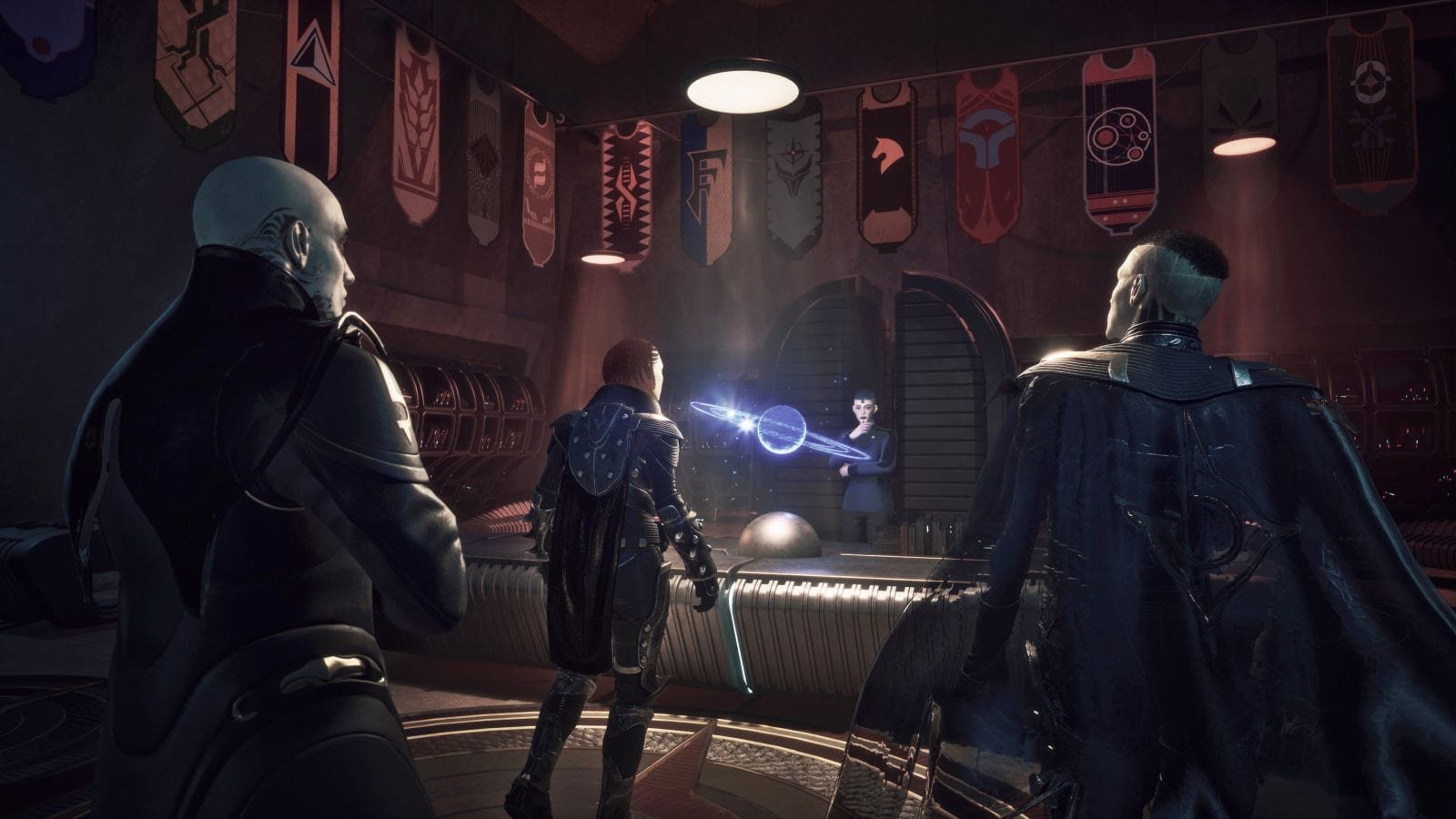
The Landsraad is the central endgame system, running in weekly cycles. Guilds aligned with major factions compete to win favor with 25 Great Houses by completing tasks and earning influence.
These tasks span all types of gameplay:
- Crafting: Deliver stillsuits, weapons, or even vehicles
- Exploration: Discover wrecks or buried artifacts
- PvP: Seize control points in the Deep Desert
- Trading: Deliver requested goods or bribe House reps
The faster your guild reveals a House’s objective and completes it, the more time you have to secure influence and advance your side on the Landsraad Board—a “bingo-style” grid where the first to complete five aligned objectives can trigger an early victory through a political maneuver called a Cis-Laurad.
Even if no faction completes a full line, the one with the most completed House objectives by week’s end wins the round—and the right to choose powerful decrees that affect every player on that world.
Decrees: Changing the Rules of the Game
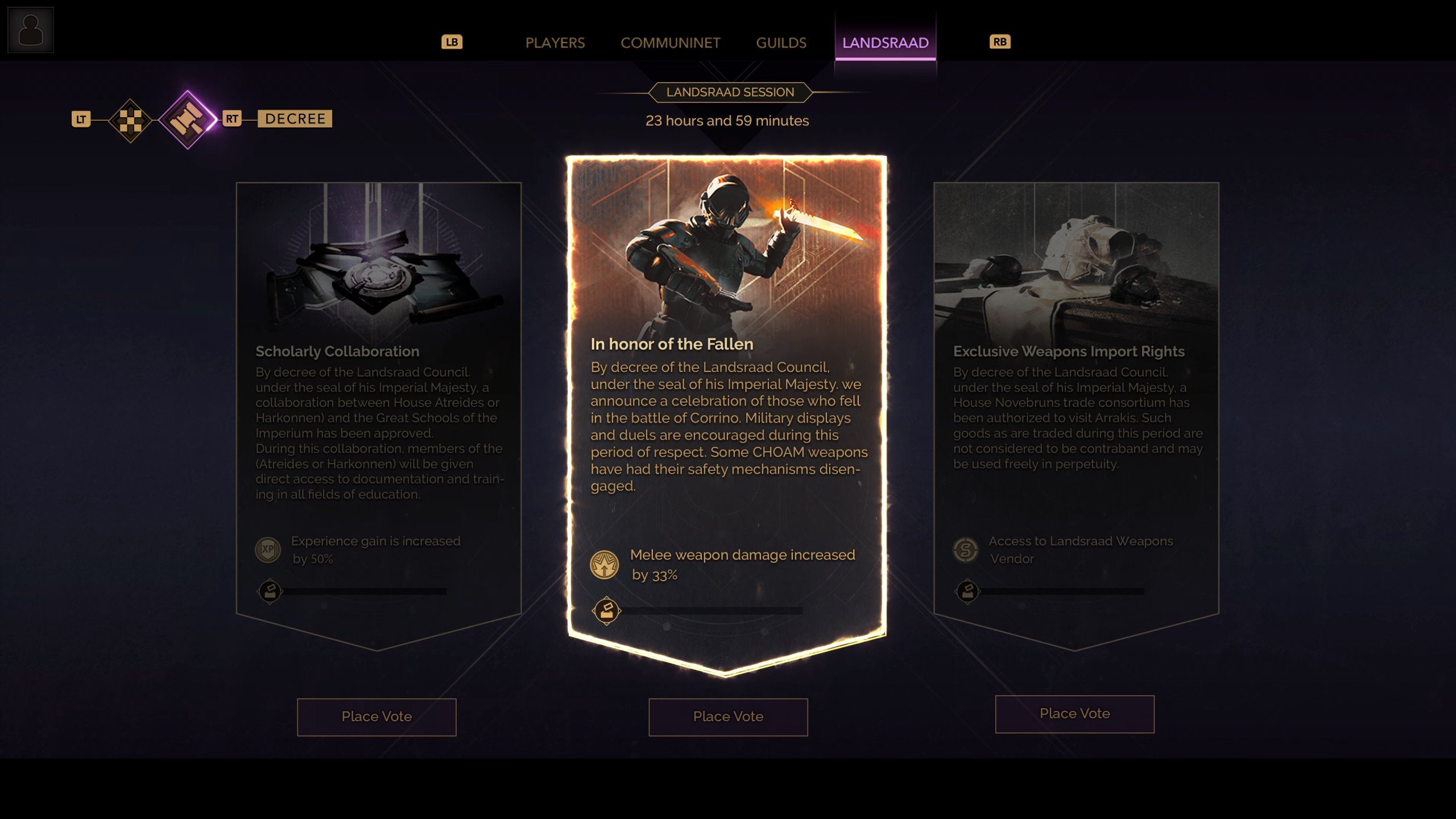
Decrees are world-altering modifiers chosen by the top-contributing guilds of the winning faction. Examples include:
- Full Loot PvP: Every item drops in the Deep Desert for a week
- Discounted Crafting: Lower material costs for key gear types
- Vendor Unlocks: Access exclusive traders with elite schematics and rare gear
- Faster Extraction: Boosts to spice harvesting or vehicle fabrication
Guilds earn voting power based on their contribution during the week—so even within factions, competition is fierce to be among the top guilds when it’s time to vote.
The Deep Desert: High Risk, High Reward PvP
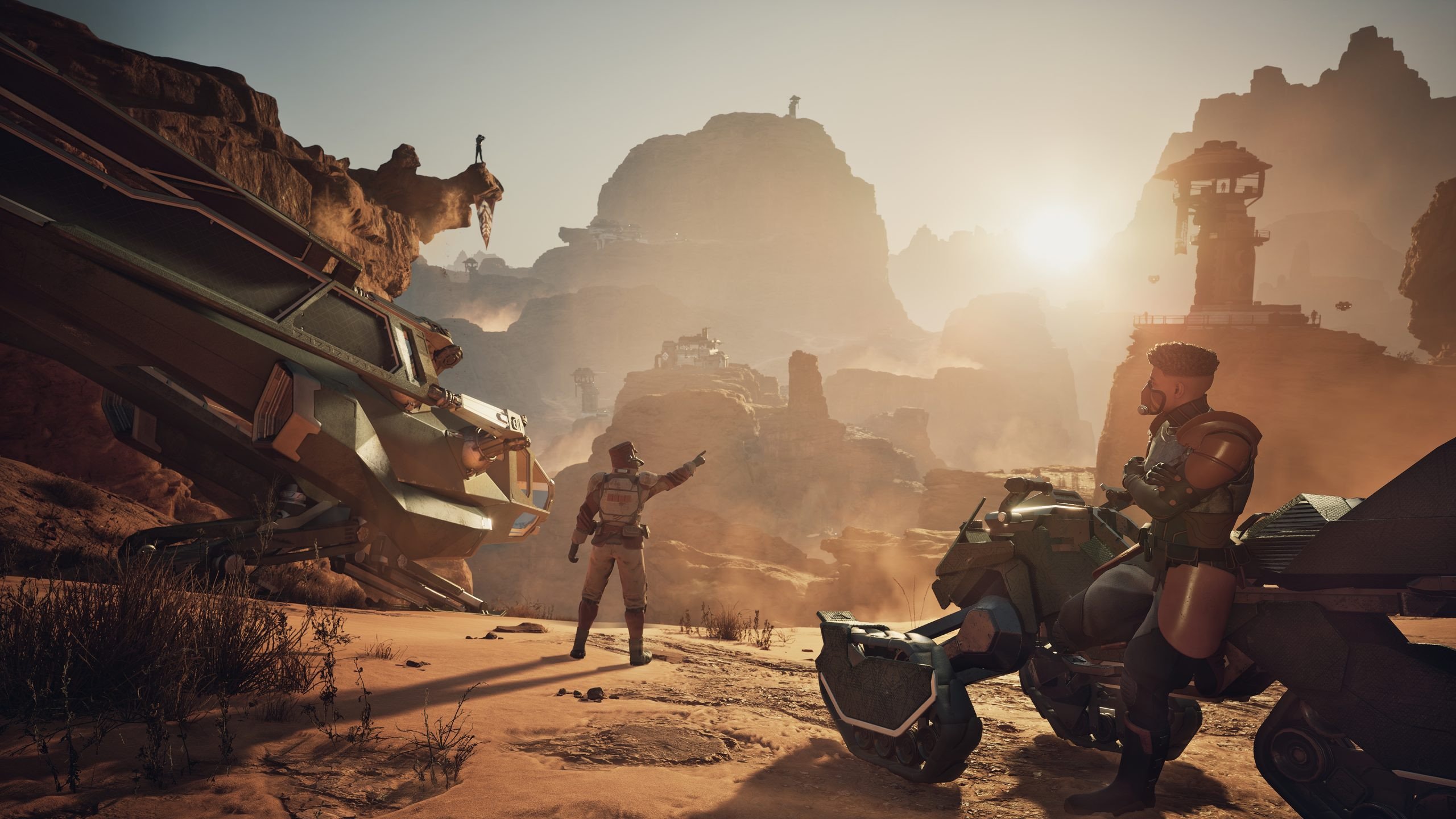
The Deep Desert is Dune Awakening’s opt-in PvP endgame zone and the heart of high-tier resource gathering and guild conflict. It’s reset weekly and includes 81 randomized sectors, encouraging repeated exploration and conflict over scarce rewards.
Features of the Deep Desert:
- Coriolis Storms: Dangerous weather that disables shields and disrupts combat
- Shield Downtime: Managing Holtzman shield usage becomes crucial—especially when paired with PvP rules
- Surveying: Solo players and guild scouts can map high-yield resource nodes and sell them on the Exchange
- Control Points: PvP objectives that feed into the Landsraad political board
This region is fully opt-in PvP, meaning it’s not safe—even if you’re just exploring. However, it’s also the source of:
- Endgame schematics
- Exotic materials
- Exclusive PvP and faction tasks
Deep Desert is meant to be played by groups of players rather than solo players.
Personal Rewards and Reputation
Even if your guild or faction doesn’t win the week, every player who contributes can still earn:
- Solari payouts
- Crafting materials
- Faction cosmetics (House color swatches)
- Unique schematics
You also build personal reputation with individual Great Houses, which may impact future dialogue, rewards, or quest outcomes. Some Houses respond more favorably based on your background, class, or previous decisions.
Conclusion
Thanks to the unique setting of Arrakis, Dune Awakening is your typical survival game with base building and raiding, but coated in unique survival, trading, and PvP mechanics. So, even if you played similar games, there will be things that you’ll need to learn, which is like a breath of fresh air in the genre. While the first hours in the game might feel dull or too harsh, the combat might feel unnecessarily complex, but it gets better as you progress your character and get better gear. If you’re interested in the endgame, the game does offer some unique ways to wage war and trade between player guilds, which is not something you see a lot in similar games. Hopefully, this guide made you realize how unique this take on Dune is, and you got motivated to try the game for yourself.
F.A.Q.
What is the best beginner class in Dune: Awakening?
The Trooper is a great starter class due to its focus on ranged combat, simple abilities, and survivability. It helps deal with early-game PvE enemies who typically use melee weapons.
How to be good in Dune: Awakening?
The game will take time getting used to.
- Learn when to switch between ranged and melee, especially against shielded enemies
- Focus early on crafting better gear and tools
- Use the Research system to unlock schematics that match your playstyle
Is Dune: Awakening easy?
Not really. The game has survival mechanics, punishing PvE groups, and stamina-based combat that requires tactical thinking. You can easily get overwhelmed if you’re unprepared or solo.
What to do when you first start in Dune: Awakening?
All you have to do is follow the tutorial tasks that will take you through the basics of the game:
- Craft a Scrap Metal Knife to progress through blocked areas
- Complete the tutorial objectives to unlock basic blueprints
- Gather resources and Intel Points for early Research unlocks
How to become good at Dune: Awakening?
Mastering weapon swaps and stagger mechanics in combat is key. Also, specialize through Research, gather water often, and scout POIs for resources and schematics. Play with or join a guild for more support.
What is the best beginner weapon in Dune: Awakening?
Karpov 38 Rifle is the best weapon for Hagga Basin, which is the starting location. Once you move to another zone, you’re going to need to upgrade to something more powerful.
Is Dune: Awakening combat easy?
It starts simple but ramps up fast. Shield mechanics, stamina limits, and AI group behavior make combat dangerous if you’re careless. Awareness and gear progression are essential.



